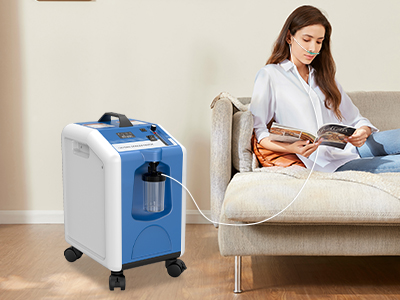18 May 2024
Oxygen therapy is a medical intervention that through an oxygen concentrator provides supplemental oxygen to individuals whose lungs cannot deliver adequate oxygen to the body.
Pulmonary fibrosis is a chronic and progressive lung disease characterized by the thickening and scarring of lung tissue. This scarring, known as fibrosis, impedes the lung's ability to transport oxygen into the bloodstream, resulting in decreased oxygen levels and impaired respiratory function.

Understanding Pulmonary Fibrosis
A. Causes and Risk Factors
Pulmonary fibrosis can arise from various causes, including environmental factors, genetic predisposition, and autoimmune diseases. Exposure to certain toxins, such as asbestos or silica dust, can trigger the condition. Additionally, smoking and certain viral infections have been identified as risk factors.
B. Symptoms and Diagnosis
Common symptoms of pulmonary fibrosis include persistent dry cough, shortness of breath, fatigue, and chest discomfort. Diagnosing this condition typically involves imaging tests, such as high-resolution CT scans, pulmonary function tests, and sometimes lung biopsies.
C. Progression and Prognosis
The progression of pulmonary fibrosis varies among individuals, with some experiencing rapid decline while others face a slower course. The prognosis is generally poor, with a median survival rate of three to five years after diagnosis. However, advancements in treatments are providing hope for better management of the disease.
The Role of Oxygen Therapy
A. What is Oxygen Therapy?
Oxygen therapy involves the administration of oxygen at concentrations higher than those found in ambient air. It is designed to alleviate hypoxemia (low blood oxygen levels) and support the respiratory function of individuals with chronic lung conditions.
B. How Oxygen Therapy Works
Oxygen therapy increases the availability of oxygen to the lungs, which in turn enhances the amount of oxygen that reaches the bloodstream. This helps alleviate the symptoms associated with low oxygen levels, such as shortness of breath and fatigue.
C. Types of Oxygen Therapy
There are various types of oxygen therapy, including continuous flow oxygen, where oxygen is delivered at a constant rate, and pulse dose oxygen, which delivers oxygen in bursts synchronized with the patient's breathing. The choice of therapy depends on the patient's specific needs and lifestyle.
Benefits of Oxygen Therapy for Pulmonary Fibrosis
A. Improving Blood Oxygen Levels
One of the primary benefits of oxygen therapy is the improvement of blood oxygen levels. This is crucial for patients with pulmonary fibrosis, whose lung function is compromised, leading to inadequate oxygenation of the blood.
B. Enhancing Quality of Life
Oxygen therapy can significantly enhance the quality of life for patients with pulmonary fibrosis. By alleviating symptoms such as breathlessness and fatigue, patients can engage in daily activities with greater ease and comfort.
C. Reducing Symptoms and Complications
Oxygen therapy helps reduce the severity of symptoms and prevent complications associated with pulmonary fibrosis, such as heart failure and pulmonary hypertension. This intervention can also improve sleep quality and overall well-being.

Oxygen Therapy Methods
A. Continuous Flow vs. Pulse Dose
Continuous flow oxygen therapy provides a steady stream of oxygen, while pulse dose therapy delivers oxygen in short bursts. Each method has its advantages, with continuous flow being suitable for stationary use and pulse dose offering greater portability and efficiency.
B. Different Delivery Systems
Oxygen can be delivered through various systems, including nasal cannulas, which are comfortable and convenient for long-term use, and masks, which are often used for higher oxygen concentrations or during sleep.
C. Portable Oxygen Concentrators vs. Stationary Units
Portable oxygen concentrators offer mobility and convenience, allowing patients to maintain an active lifestyle. In contrast, stationary units provide a consistent oxygen supply for home use. The choice depends on the patient's activity level and oxygen needs.
Considerations and Precautions
A. Prescription and Medical Supervision
Oxygen therapy requires a prescription and ongoing medical supervision to ensure its effectiveness and safety. Patients must adhere to their prescribed oxygen levels and usage instructions.
B. Potential Side Effects
While oxygen therapy is generally safe, it can have side effects, such as nasal dryness or irritation. Patients should report any adverse effects to their healthcare provider for appropriate management.
C. Lifestyle Adjustments and Compliance
Adapting to oxygen therapy may require lifestyle adjustments, such as avoiding smoking and maintaining a clean, dust-free environment. Compliance with the therapy regimen is essential for optimal benefits.
Complementary Treatments
A. Pulmonary Rehabilitation
Pulmonary rehabilitation programs, which include exercise training, nutritional counseling, and education, complement oxygen therapy by improving physical fitness and respiratory function.
B. Medications and Therapies
Medications, such as antifibrotic agents, and other therapies, including lung transplantation, may be considered in conjunction with oxygen therapy to manage pulmonary fibrosis effectively.
C. Lifestyle Modifications
Lifestyle modifications, such as maintaining a healthy diet, staying physically active, and avoiding respiratory irritants, play a crucial role in managing pulmonary fibrosis and enhancing the effectiveness of oxygen therapy.
Case Studies and Research
A. Clinical Studies on Oxygen Therapy for Pulmonary Fibrosis
Clinical studies have demonstrated the benefits of oxygen therapy in improving survival rates, reducing hospitalizations, and enhancing quality of life for patients with pulmonary fibrosis.
B. Patient Testimonials
Patient testimonials highlight the positive impact of oxygen therapy on daily living, providing valuable insights into the real-world benefits of this treatment.
C. Future Directions in Treatment
Ongoing research is focused on developing new therapies and improving existing ones to better manage pulmonary fibrosis and enhance patient outcomes.
Conclusion
A. Summary of Key Points
Oxygen therapy plays a vital role in the management of pulmonary fibrosis, offering numerous benefits such as improved blood oxygen levels, enhanced quality of life, and reduced symptoms.
B. The Importance of Personalized Treatment Plans
Personalized treatment plans, including oxygen therapy and complementary treatments, are essential for effectively managing pulmonary fibrosis and improving patient outcomes. By adhering to prescribed therapies and making necessary lifestyle adjustments, patients can achieve better control over their condition and enjoy a higher quality of life.
Keywords: oxygen concentrator
Originally published 18 May 2024, updated 18 May 2024.